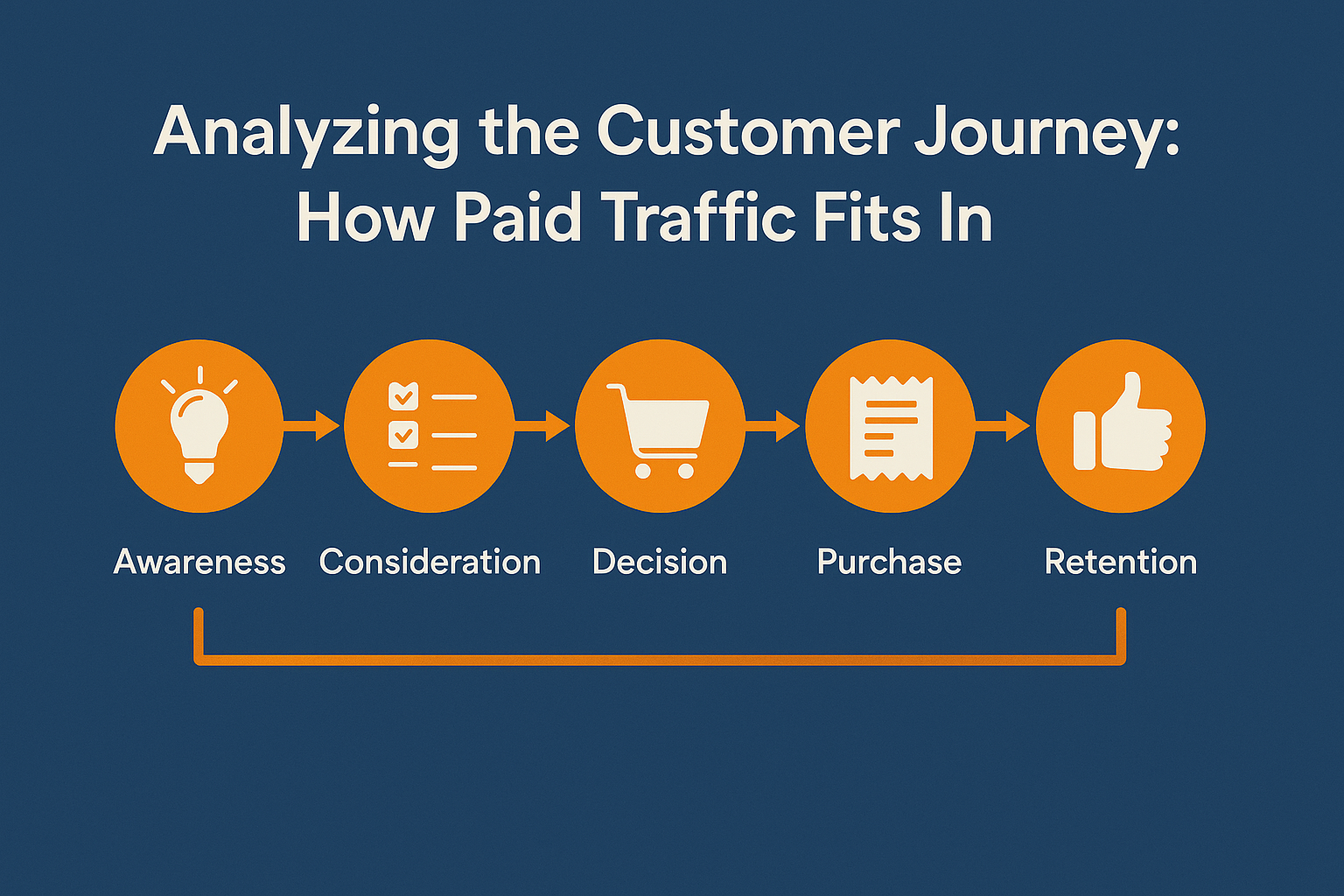If you’re running ads without understanding the customer journey, you’re just shooting in the dark.
Paid traffic can be powerful—but to get real results, you need to know where it fits into your customer’s decision-making process.
In this article, we’ll break down:
- What the customer journey really is
- How buyers think and behave at each stage
- Where paid ads work best
- And how to align your ad strategy with the journey to drive more conversions
What Is the Customer Journey?
The customer journey is the path someone takes from the moment they become aware of a problem or need—until they make a purchase (and beyond).
It’s not a straight line. It’s emotional, messy, and full of questions like:
- “Do I really need this?”
- “Who can I trust?”
- “Is this worth the money?”
Your job as a marketer is to guide them through the journey—step by step.
The 5 Stages of the Customer Journey
Let’s break it down using a simple framework:
1. Awareness
They realize they have a problem or desire.
→ “I need to get more clients.”
→ “My skin is breaking out again.”
2. Consideration
They start researching solutions.
→ “Should I hire a coach or take a course?”
→ “Which skincare routine works for oily skin?”
3. Decision
They compare options and decide who to trust.
→ “This product has great reviews.”
→ “That brand seems credible.”
4. Purchase
They make the decision to buy or sign up.
→ “Let’s go. I’m ready.”
5. Retention & Loyalty
They use the product and (hopefully) become a fan.
→ “This really worked. I’d buy again.”
→ “Let me recommend this to my friend.”
How Paid Traffic Supports Each Stage
Now let’s look at how paid ads can support every step of this journey.
Stage 1: Awareness – Use Ads to Start the Conversation
At this point, people don’t know you yet.
They may not even realize they need your product or service.
✅ Best ad formats:
- Short videos that entertain or educate
- Reels or TikToks that highlight a pain point
- Blog posts or tips promoted via Facebook/Instagram ads
- YouTube ads with a “did you know” hook
🎯 Objective: Engagement, Reach, or Video Views
🧠 Goal: Get attention and plant the idea.
Stage 2: Consideration – Use Ads to Build Trust and Authority
Now the user is aware of their problem and is looking for solutions.
This is where you step in with:
- Lead magnets (free guides, checklists, email courses)
- Case studies or client success stories
- Webinar invitations
- Product comparison ads
🎯 Objective: Lead Generation, Website Traffic, Landing Page Views
🧠 Goal: Show you understand their problem—and you have a real solution.
Stage 3: Decision – Use Ads to Nudge and Convert
At this stage, the buyer is comparing options and needs a final push.
Use:
- Testimonials and reviews
- Risk-reducers (guarantees, FAQs, live chat)
- Scarcity or urgency (limited spots, countdown timers)
- Discounts or special offers for warm leads
🎯 Objective: Conversions, Purchases, or Bookings
🧠 Goal: Reassure them. Help them commit.
Stage 4: Purchase – Use Ads to Maximize the Sale
Someone just bought? That’s not the end—it’s the perfect time to:
- Offer an upsell or add-on
- Promote a bundle
- Invite them to join a community
- Ask for a review or referral
🎯 Objective: Retargeting, In-App Purchases, Messenger
🧠 Goal: Increase order value and loyalty.
Stage 5: Retention – Use Ads to Keep Them Engaged
Paid traffic can help you stay top of mind, especially for e-commerce or subscription businesses.
Try:
- Ads promoting exclusive content
- Retargeting past customers with new releases
- Loyalty programs or “members-only” deals
- Re-engagement campaigns
🎯 Objective: Reach, Catalog Sales, Engagement
🧠 Goal: Turn customers into fans and advocates.
Matching Your Message to the Journey
Here’s a simplified cheat sheet:
| Stage | Mindset | Best Ads | CTA Example |
|---|---|---|---|
| Awareness | “I have a problem.” | Video, Blog, Social Tips | “Learn more” |
| Consideration | “What are my options?” | Lead Magnet, Webinar | “Download free guide” |
| Decision | “Who do I trust?” | Testimonials, Offers | “Buy now” |
| Purchase | “I’m ready.” | Upsell, Review Ask | “Add to cart” / “Share now” |
| Retention | “What else can I get?” | Loyalty, New Product | “Shop again” / “Earn rewards” |
Why This Matters for Your Ad Strategy
Too many advertisers focus only on the purchase stage.
But most of your audience is not ready to buy yet.
When you map your paid traffic strategy to the full customer journey, you:
- Build trust earlier
- Reduce ad costs (by warming up cold traffic)
- Increase conversions
- Improve long-term customer value
It’s not about pushing harder—it’s about guiding smarter.
Final Thoughts: Great Ads Follow the Customer Journey
Paid traffic is more than just targeting and creative—it’s about timing and psychology.
If you want better results:
- Stop selling to cold leads
- Start building relationships with your ads
- Support every stage of the journey—not just the bottom
When you meet people where they are, your ads stop feeling like ads—and start feeling like help.
That’s when conversions really begin.
